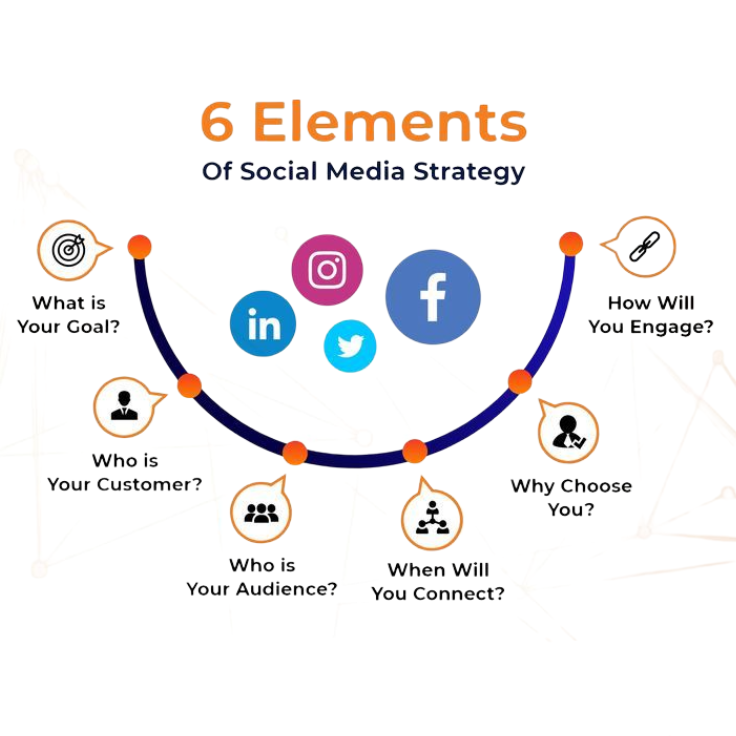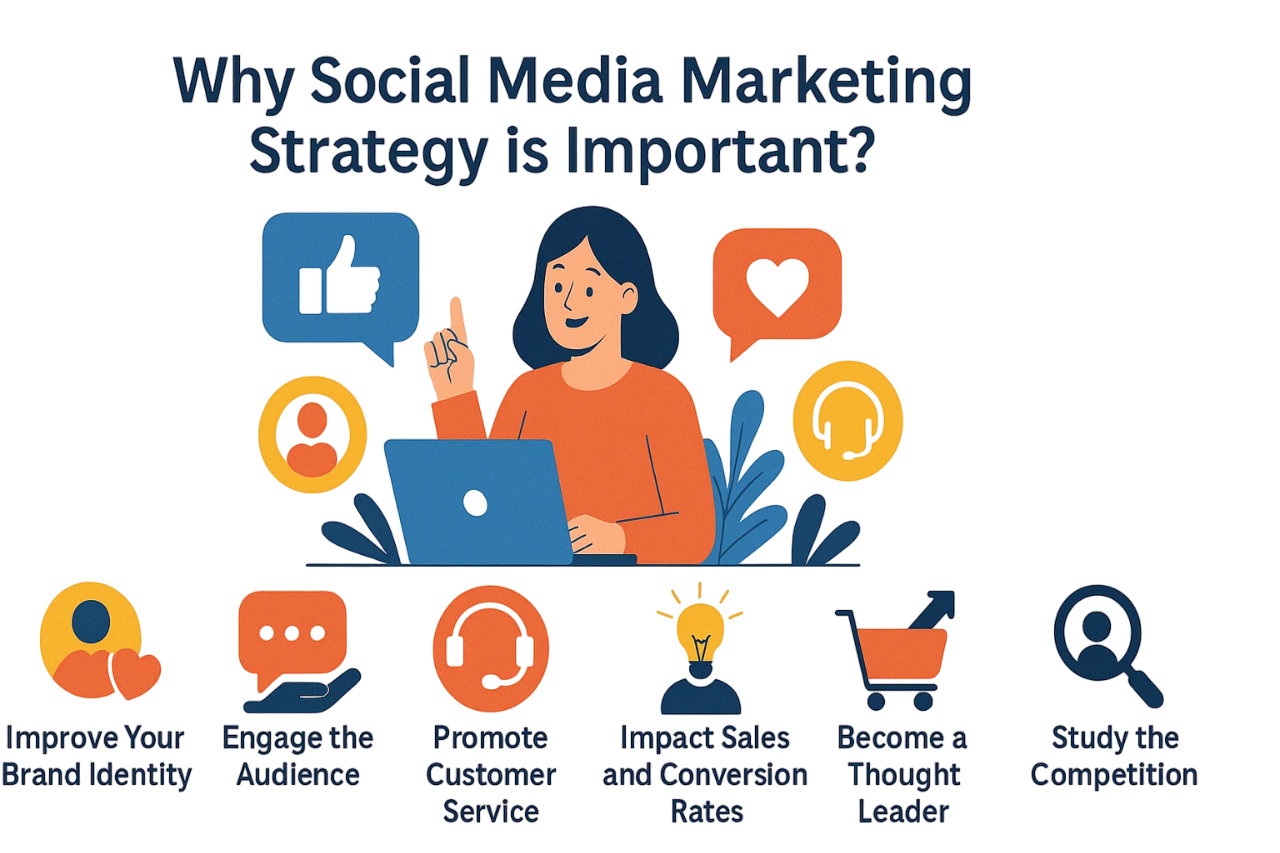
- Introduction: What is a Social Media Marketing Strategy?
- Why You Need a Social Media Marketing Strategy
- Key Components of a Successful Social Media Marketing Strategy
- Step-by-Step Guide to Creating Your Social Media Marketing Strategy
- Popular Social Media Marketing Strategies
- Tools to Help You Manage Your Social Media Strategy
- Common Mistakes to Avoid
- The Future of Social Media Marketing Strategy
- Conclusion
Introduction: What is a Social Media Marketing Strategy?
A social media marketing strategy is a clearly defined plan that outlines how a business or individual will use social media platforms to achieve specific marketing goals. This strategy includes everything from identifying target audiences and choosing the best platforms to creating content and measuring success an end-to-end framework taught in Digital Marketing Training, where learners build audience personas, select optimal channels, craft resonant messaging, and apply performance metrics to refine campaigns and achieve measurable growth. Having a strategy ensures your social media efforts are coordinated, efficient, and aligned with your broader marketing and business objectives.
Ready to Get Certified in Digital Marketing? Explore the Program Now Digital Marketing Online Training Offered By ACTE Right Now!
Why You Need a Social Media Marketing Strategy
In today’s fast-changing digital world, social media needs more than just eye-catching content. A clear strategy is essential for turning random posts into effective marketing efforts. By creating a solid social media plan, businesses can direct their resources toward reaching the right audience, which greatly boosts brand awareness and customer engagement a strategic capability emphasized in Career Paths for Today’s SEO Specialist, where professionals explore roles like Social Media Marketer and Digital Strategist, mastering audience segmentation, platform targeting, and content alignment to drive measurable growth through optimized engagement. This organized approach not only helps use time and budget more effectively but also allows for measuring return on investment and responding quickly to shifts in the market. Additionally, a well-designed strategy gives businesses a strong edge by allowing them to understand new trends and consumer behaviors. This ensures that social media becomes a valuable tool for business growth instead of a collection of unrelated posts.
Key Components of a Successful Social Media Marketing Strategy
A successful strategy includes:
- Clear Goals: What do you want to achieve? (e.g., awareness, leads, sales)
- Audience Insight: Who are you talking to?
- Platform Selection: Where does your audience spend time?
- Content Plan: What kind of content will you create and share?
- Posting Schedule: When and how often will you post?
- Engagement Plan: How will you interact with followers?
- Budget Allocation: How much will you invest in paid promotions?
- Measurement: How will you track success and optimize?
- Increase Instagram followers by 25% in 6 months
- Generate 100 leads via Facebook ads quarterly
- Boost website traffic from social media by 30%
- Demographics (age, gender, location)
- Interests and behaviors
- Pain points and needs
- Preferred social media platforms
- Facebook: Broad audience, good for B2C and B2B
- Instagram: Visual-centric, younger audience, great for lifestyle brands
- LinkedIn: Professional network, ideal for B2B
- Twitter: Real-time updates and conversations
- TikTok: Short-form videos, Gen Z audience
- Pinterest: Visual inspiration, popular for fashion, food, DIY
- Which platforms do they use?
- What content performs best?
- How often do they post?
- What engagement tactics do they employ?
- Educational content
- Entertaining posts
- User-generated content
- Promotional offers
- Behind-the-scenes glimpses
- Testimonials and reviews
- Best days/times to post per platform
- Balancing promotional vs. non-promotional content
- Frequency e.g., daily on Instagram, 3–4 times/week on LinkedIn
- Content creation (graphics, videos, copywriting)
- Paid ads and boosting posts
- Social media tools and management
- Influencer partnerships
- Engagement rate
- Follower growth
- Website traffic
- Lead conversions
- Ad performance
- Posting without a clear strategy or goal
- Ignoring audience engagement
- Over-promoting products
- Inconsistent posting schedule
- Neglecting analytics and optimization
- Copying competitors blindly
- Growth of short-form video content
- Increased use of AI for personalization
- Rise of social commerce and in-app shopping
- Enhanced AR/VR experiences
- Greater emphasis on data privacy and ethical marketing

To Explore Digital Marketing in Depth, Check Out Our Comprehensive Digital Marketing Online Training To Gain Insights From Our Experts!
Step-by-Step Guide to Creating Your Social Media Marketing Strategy
Define Your Goals and Objectives
Start with SMART goals: Specific, Measurable, Achievable, Relevant, and Time-bound a foundational framework emphasized in Digital Marketing Certification Process, where learners develop strategic clarity, align objectives with performance metrics, and apply structured goal-setting to drive measurable outcomes across SEO, content, and campaign execution.
Examples:
Identify Your Target Audience
Understand your audience’s:
Tools like Facebook Audience Insights or Google Analytics can help.
Choose the Right Social Media Platforms
Not all platforms fit every business. Consider:
Analyze Competitors
Study what your competitors are doing right and wrong:
Use tools like SEMrush, BuzzSumo, or Social Blade.
Plan Content Strategy
Create a content mix that may include:
Aim for content that provides value and aligns with your brand voice.
Develop a Posting Schedule and Frequency
Consistency matters. Use a content calendar to plan posts around events, holidays, and campaigns.
Consider:
Set a Budget
Decide how much to spend on:
Monitor, Analyze, and Optimize
Track KPIs such as:
Use insights to tweak your strategy continually.
Popular Social Media Marketing Strategies
Brands are changing their marketing strategies by using thorough social media methods. By working with influencers for genuine brand promotion, running targeted paid ads, and making valuable content that educates and entertains, companies can engage their audience effectively.

The focus is on encouraging community conversations, promoting user-generated content, and exploring new platforms like social commerce, which allows direct selling through channels like Instagram Shopping emerging trends covered in Digital Marketing Training, where learners master engagement strategies, UGC integration, and platform commerce techniques to build authentic brand communities and drive conversions through interactive, audience-first experiences. This all-inclusive approach not only boosts brand visibility but also builds real connections with followers. It turns passive consumers into loyal brand advocates who get involved in and contribute to the brand’s story.
Looking to Digital Marketing Training? Discover the Digital Marketing Expert Masters Program Training Course Available at ACTE Now!
Tools to Help You Manage Your Social Media Strategy
Using the right tools can greatly improve a brand’s social media strategy. For scheduling and managing content, platforms like Buffer, Hootsuite, and Later provide easy solutions for social media posting. Alongside these tools, analytics platforms such as Sprout Social, Google Analytics, and Facebook Insights offer valuable insights into audience engagement and campaign performance. Creating content is simple with design tools like Canva and Adobe Spark, which allow marketers to make eye-catching graphics a creative shift shaped by the History & Evolution of Digital Marketing, where the transition from static websites to dynamic, visual-first platforms empowered brands to communicate more effectively, personalize outreach, and scale design workflows for modern digital campaigns. Social listening tools, including Brandwatch and Mention, help brands keep up with online conversations and sentiments. Meanwhile, advertising platforms like Facebook Ads Manager and Google Ads support targeted marketing campaigns based on data. By thoughtfully combining these effective tools, businesses can build a strong social media presence that fosters meaningful engagement and delivers measurable results.
Common Mistakes to Avoid
Social Media Mistakes to Avoid:
Preparing for Digital Marketing Job Interviews? Have a Look at Our Blog on Digital Marketing Interview Questions and Answers To Ace Your Interview!
The Future of Social Media Marketing Strategy
Key Digital Marketing Trends: AI-powered personalization, voice search optimization, cookie-free data strategies, and social commerce are reshaping how brands connect with audiences insights shared by Digital Marketing Experts, who emphasize the shift from keyword-centric tactics to contextual relevance, predictive analytics, and immersive experiences that drive engagement and conversion in 2025’s evolving landscape.
Conclusion
Creating an effective social media marketing strategy is essential for any brand that wants to succeed online. It’s not just a bonus; it’s necessary. To start, you need to truly understand your audience. Knowing who they are and what they like helps you create content that matches their interests. Setting clear goals is also important. What do you want to achieve? Whether it’s gaining followers, increasing engagement, or driving traffic to your website, having specific objectives will direct your efforts an essential framework taught in Digital Marketing Training, where learners apply SMART goal-setting techniques to align marketing tactics with business outcomes, optimize resource allocation, and measure success across key performance indicators. Next, planning regular content is key. Sticking to a posting schedule keeps your brand visible, making it more likely that your audience will remember you. This can include entertaining posts, informative articles, or engaging videos that connect with your followers. Finally, don’t overlook the need for ongoing improvement. Social media trends shift quickly, and your approach should as well. By looking at what works and what doesn’t, you can adjust your strategy to improve your results over time.




